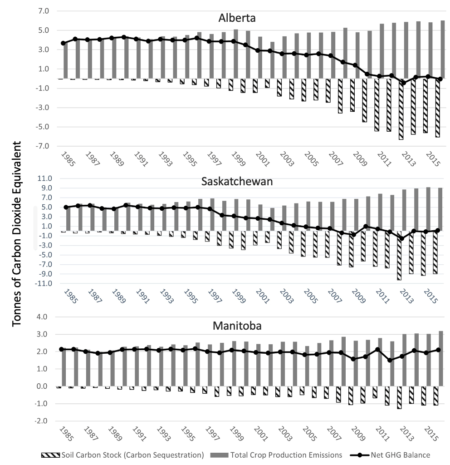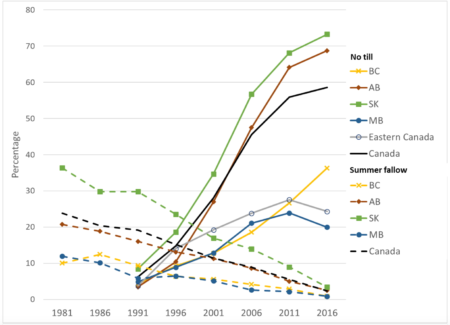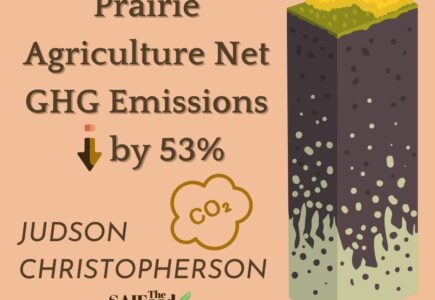Introduction
In the past 30 years, grain and oilseed production across the prairies has undergone fundamental change. In the early 1990s, practices such as summerfallow and conventional tillage were common. During this time, 55%, 32%, and 13% of acres in Saskatchewan were under conventional-, minimal-, and zero-tillage management, respectively. Intensive tillage methods of crop production are known to release soil organic carbon (SOC) stored in the soil by plants however, these practices were required to successfully grow crops given the state of technology. Rapid and monumental advancements in plant genetics, pesticides, and machinery have fostered the ways farmers grow crops.
Sources and Sinks in Crop Production
A recent modelling exercise studied net crop production emissions on the Canadian prairie provinces, modelling emissions from land, fuel, and fertilizer use in crop production systems. These emission sources are dependent on a multitude of factors and the subsequent modelling processes were adapted to account for these dynamics. This included accounting for differences in the intensity of production by measuring fuel emissions from crop production and transportation, summerfallow incidence, tillage regime, residue retention, and the quantity of nitrogen fertilizer applied.
An important consideration of any carbon modelling exercise is that soils can be either a sink or source of carbon emissions. As plants grow, they take carbon from the air, and store it in the soil where it becomes SOC. Likewise, the incorporation of plant matter into the soil enables carbon sequestration by building SOC; the breakdown of soil organic matter generates carbon dioxide emissions. The difference between emissions and sequestration is referred to as soil carbon stock. If sequestration is greater than emissions, the land use is a net carbon sink; however, if the opposite is true, the production system is a net carbon emitter.
Alongside the direct emission and sequestration of carbon, other greenhouse gases such as nitrogen are important considerations in agricultural emission modelling practices. The use of nitrogen fertilizer, summerfallow, and crop residue retention can release nitrogen into the atmosphere. Nitrogen fertilizer applications are accounted for based on application rates, and adjusted for the climate in each region of the Canadian prairie region. Similarly, emissions from summerfallow and residue decomposition are indexed via regional coefficients to ensure variances in climatic conditions are accounted for. In general, increased soil moisture, nitrogen, and carbon content alongside higher temperatures can result in higher levels of nitrogen emissions, especially during periods of summerfallow.
Accounting for each these metrics, a net emissions figure representative of Canadian prairie crop production can be determined. Net emissions are estimated as the amount of soil sequestered or emitted (that is, the change in soil carbon stock) plus the carbon emissions from other sources and the nitrogen emission converted to CO2 equivalents.
Crop Production – A Net Carbon Sink
Accounting for all the numerous factors encompassing emissions and sequestration in crop production systems, recent modelling has displayed the monumental impact of reducing tillage intensity, summerfallow acres, and residue removal. Findings indicate that these reductions and the accompanying increase to soil carbon sequestration capacity, have made prairie agriculture a net carbon sink, particularly in Saskatchewan and Alberta. Figure 1 illustrates the net carbon changes from agricultural soils in the three prairie province spanning 1985-2016.

Demonstrating the importance of reduced tillage regarding carbon sequestration, Figure 2 outlines the tillage intensity of the Canadian provinces. Noticeably, Manitoba, British Columbia, and Eastern Canada have not adopted zero-till systems to the extent of Saskatchewan and Alberta. As such, the formerly mentioned jurisdictions have not achieved net sink status, as intensive tillage to manage land under higher moisture load is still common practice in the province.

Accompanying the adoption of zero-till, reductions in summerfallow acreage has been steady in the 35 years preceding 2016. In combination, these changes in practice have facilitated the net sink results for Saskatchewan and Alberta in recent years.
Maintaining Sink Status
Reductions in summerfallow and the adoption of zero-till systems are obviously critical components of increased environmental sustainability efforts in agricultural systems. These changes in practice, facilitated by a myriad of innovations, fostered the elimination of tillage and summerfallow. Namely, the advent of glyphosate, crop rotations, and herbicide tolerant crops have enabled this transition. According to prairie farmers, in the absence of these advancements, tillage passes would increase, summerfallow would become commonplace, and crop rotations would be difficult to maintain. Undoubtedly, this would have severe negative impacts on the environmental sustainability of Canadian prairie crop production, with lowered soil sequestration capacity, higher soil erosion, and lower profitability sure to follow.
Conclusion
The results of scientific, peer-reviewed, applied research have displayed the meaningful progress in crop production systems in Saskatchewan and Alberta. When comparing these results to Canada’s climate targets in the Paris Accord (i.e. given a 2005 baseline, the target for 2030 is a 30% reduction in emissions), the results are clearly definitive.. Since 2005, emissions have decreased by 53% in prairie agriculture, indicating the strong performance of the crop production sector. However, to ensure prairie agriculture can continue to meet targets set in coming decades, access to current technologies must not be limited, and further innovations are required to ensure agriculture can progress sustainably.


